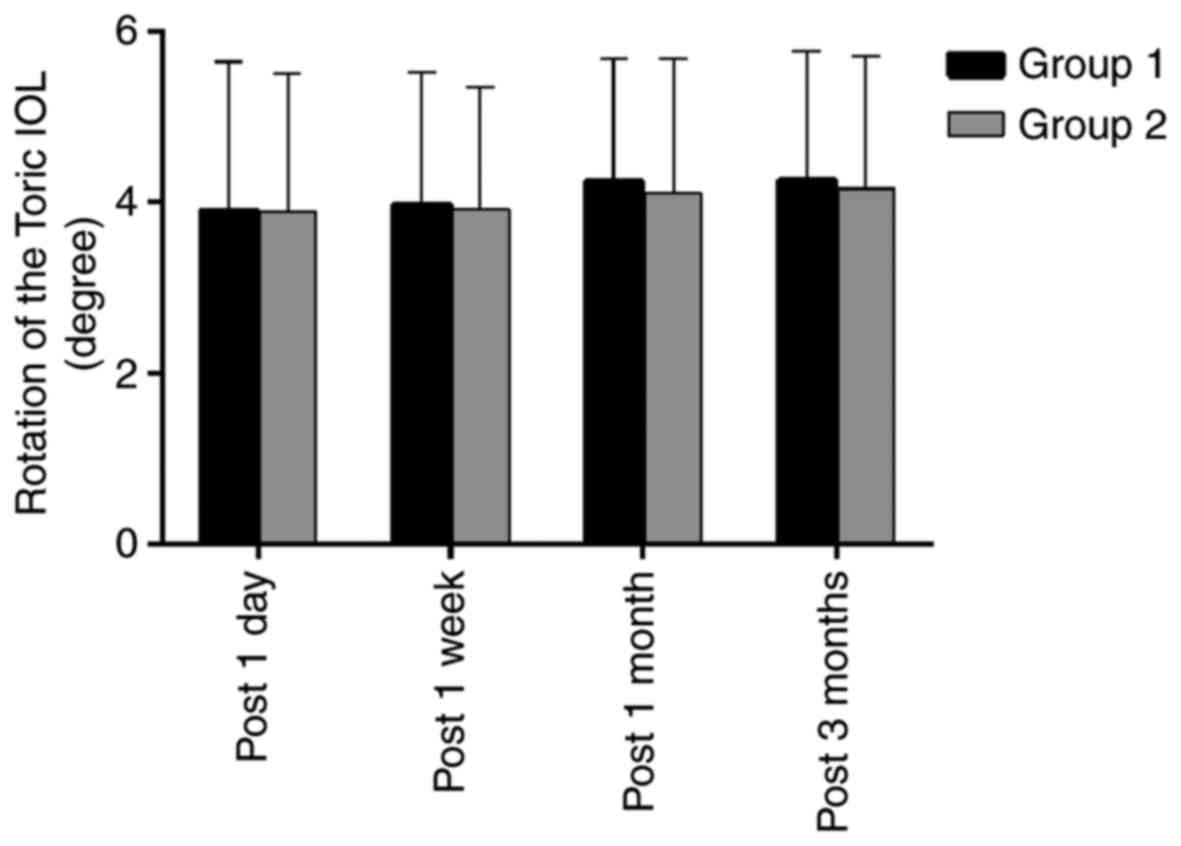|
1
|
Talley-Rostov A: Patient-centered care and
refractive cataract surgery. Curr Opin Ophthalmol. 19:5–9. 2008.
View Article : Google Scholar : PubMed/NCBI
|
|
2
|
Yang LH and Tang X: The research progress
in treating astigmatism at the time of cataract surgery. Zhonghua
Yan Ke Za Zhi. 47:573–576. 2011.(In Chinese). PubMed/NCBI
|
|
3
|
Amesbury EC and Miller KM: Correction of
astigmatism at the time of cataract surgery. Curr Opin Ophthalmol.
20:19–24. 2009. View Article : Google Scholar : PubMed/NCBI
|
|
4
|
Buckhurst PJ, Wolffsohn JS, Davies LN and
Naroo SA: Surgical correction of astigmatism during cataract
surgery. Clin Exp Optomet. 93:409–418. 2010. View Article : Google Scholar
|
|
5
|
Dick HB and Buchner SE: Toric phakic
intraocular lenses. Ophthalmologe. 104:1032–1040. 2007.(In German).
View Article : Google Scholar : PubMed/NCBI
|
|
6
|
Edrington TB: A literature review: The
impact of rotational stabilization methods on toric soft contact
lens performance. Cont Lens Anterior Eye. 34:104–110. 2011.
View Article : Google Scholar : PubMed/NCBI
|
|
7
|
Sun XY, Vicary D, Montgomery P and
Griffiths M: Toric intraocular lenses for correcting astigmatism in
130 eyes. Ophthalmology. 107:1776–1782. 2000. View Article : Google Scholar : PubMed/NCBI
|
|
8
|
Horn JD: Status of toric intraocular
lenses. Curr Opin Ophthalmol. 18:58–61. 2007. View Article : Google Scholar : PubMed/NCBI
|
|
9
|
Viestenz A, Walter S, Viestenz A,
Behrens-Baumann W and Langenbucher A: Toric intraocular lenses and
correction of astigmatism. Ophthalmologe. 104:620–627. 2007.(In
German). View Article : Google Scholar : PubMed/NCBI
|
|
10
|
Kurz S, Krummenauer F, Hacker P, Pfeiffer
N and Dick HB: Capsular bag shrinkage after implantation of a
capsular bending or capsular tension ring. J Cataract Refract Surg.
31:1915–1920. 2005. View Article : Google Scholar : PubMed/NCBI
|
|
11
|
Chang DF: Early rotational stability of
the longer Staar toric intraocular lens: Fifty consecutive cases. J
Cataract Refract Surg. 29:935–940. 2003. View Article : Google Scholar : PubMed/NCBI
|
|
12
|
Shah GD, Praveen MR, Vasavada AR, Vasavada
VA, Rampal G and Shastry LR: Rotational stability of a toric
intraocular lens: Influence of axial length and alignment in the
capsular bag. J Cataract Refract Surg. 38:54–59. 2012. View Article : Google Scholar : PubMed/NCBI
|
|
13
|
Saw SM, Gazzard G, Shih-Yen EC and Chua
WH: Myopia and associated pathological complications. Ophthalmic
Physiol Opt. 25:381–391. 2005. View Article : Google Scholar : PubMed/NCBI
|
|
14
|
Liu YC, Xia WT, Zhou XT, Liu RJ, Bian SZ,
Ying CL and Zhu GY: Eyeball structure changes in high myopic
patients and their significance for forensic assessment. Fa Yi Xue
Za Zhi. 24:356–360. 2008.(In Chinese). PubMed/NCBI
|
|
15
|
Seward H, Packard R and Allen D:
Management of cataract surgery in a high myope. Br J Ophthalmol.
85:1372–1378. 2001. View Article : Google Scholar : PubMed/NCBI
|
|
16
|
Hayashi K, Kondo H, Yoshida M, Manabe S
and Hirata A: Higher-order aberrations and visual function in
pseudophakic eyes with a toric intraocular lens. J Cataract Refract
Surg. 38:1156–1165. 2012. View Article : Google Scholar : PubMed/NCBI
|
|
17
|
Kamiya K, Shimizu K, Aizawa D, Igarashi A,
Komatsu M and Nakamura A: One-year follow-up of posterior chamber
toric phakic intraocular lens implantation for moderate to high
myopic astigmatism. Ophthalmology. 117:2287–2294. 2010. View Article : Google Scholar : PubMed/NCBI
|
|
18
|
Alió JL, Piñero DP, Tomás J and Plaza AB:
Vector analysis of astigmatic changes after cataract surgery with
implantation of a new toric multifocal intraocular lens. J Cataract
Refract Surg. 37:1217–1229. 2011. View Article : Google Scholar : PubMed/NCBI
|
|
19
|
Visser N, Nuijts RM, de Vries NE and Bauer
NJ: Visual outcomes and patient satisfaction after cataract surgery
with toric multifocal intraocular lens implantation. J Cataract
Refract Surg. 37:2034–2042. 2011. View Article : Google Scholar : PubMed/NCBI
|
|
20
|
Zhu X, He W, Zhang K and Lu Y: Factors
influencing 1-year rotational stability of AcrySof Toric
intraocular lenses. Br J Ophthalmol. 100:263–268. 2016. View Article : Google Scholar : PubMed/NCBI
|
|
21
|
Becker KA, Auffarth GU and Völcker HE:
Measurement method for the determination of rotation and
decentration of intraocular lenses. Ophthalmologe. 101:600–603.
2004.(In German). PubMed/NCBI
|
|
22
|
Warlo I, Krummenauer F and Dick HB:
Rotational stability in intraocular lenses with C-loop haptics
versus Z haptics in cataract surgery. A prospective randomised
comparison. Ophthalmologe. 102:987–992. 2005.(In German).
View Article : Google Scholar : PubMed/NCBI
|
|
23
|
Viestenz A and Langenbucher A: Rotational
stability of the eye in standard photography. Klin Monbl
Augenheilkd. 221:262–265. 2004.(In German). View Article : Google Scholar : PubMed/NCBI
|













